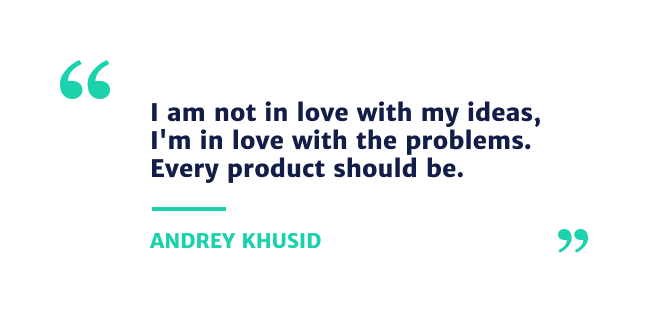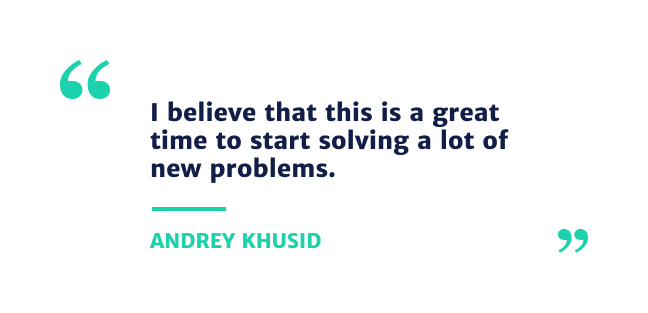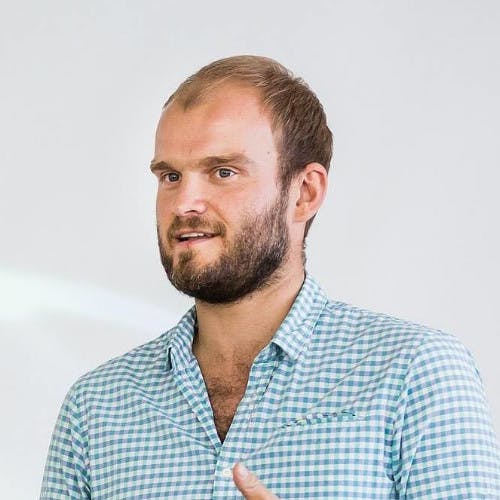Season 3 - Episode 2
Why Idea Validation is Key in Product
Andrey Khusid is the Founder and CEO of Miro, the world’s most popular online collaborative whiteboard platform. He talks us through the creation and idea behind Miro, the impact of his Product background as a CEO and the future of remote work in the Product industry.

Watch the episode here: Why Idea Validation is Key in Product
“Question [00:04:48] How did all of this start? What’s your story? ”
Andrey [00:04:53] It’s a great question. It all started in a small city in the middle of Russia where we were building that online whiteboard. We were thinking that it’s a great idea to bring the whiteboard to the browser but then we realized that it’s also a great idea to build some solutions for companies, not just like a B2C product. We started to see a pattern of a lot of companies using the product for product developments so we decided to build the product around that.
We have offices across Europe and the US; there are three offices in the US and two in Europe. We have 5 million users, and almost 25,000 customers today. It’s really impressive, because we were really proud to help companies, to help teams, solve today’s problems. Today’s problem is that with everyone working from home, you really need to communicate and connect. And there are tools to communicate and connect like Zoom and Slack, but they’re missing this visual communication piece. We’re trying to fill that visual communication piece, so people can understand each other better than when they are speaking, through a visual language. I’m happy that our team is solving this pain.
“Question [00:09:30] What would you say are some of them overlapping skills between a good Product Manager and a CEO?”
Andrey [00:09:37] I think that with a great CEO, the common thing about them is that they see patterns and they recognize the opportunities. I think that’s a skill every product manager should have. See the pattern, not optimize for one problem, but understand where the biggest problem is and recognize the opportunities. Another thing I think describes great CEOs and distinguishes them from normal, regular CEOs, is the ability to zoom in and zoom out. This is also a skill of a great product manager, zoom into small details and zoom out into a big picture to understand the big problem.
At the same time, a CEO’s job is not exactly the same as a product manager’s job. The difference is that, as a product manager, you are focused on the product and on the customer’s problem, as a CEO, you focus on a company, on the community at a bigger scale.
You might also be interested in: 6 Product Managers Who Became CEOs- and How!

“Question [00:16:01] What are some of those things that you’re intentionally doing yourself that may not scale, but you think that they’re so core to the business that it’s good for you to spend time with them? ”
Andrey [00:16:12] First of all, is customer empathy. The number one thing that I’m doing a lot is trying to keep as much connection with the customers as possible. There are all these different ways I do it. First, speaking with the customers and with those people who don’t use the products. Some people who pitch the product, you see the reaction, does it resonate? Does it not? Some people you meet and you ask, if we can do an online session or register to see how their first experience looks like. Some people you discover if they are a users or buyer personas.
At the same time, I am a big fan of NPS channels. We collect feedback from users through this channel, and I read them every day.
I read a lot of analysis from a sales team, like why customers buy us. All those kind of touch points allow me to emphasize with the customer and to understand what’s top of their head, what’s going on, where we are great, and especially, where we are not that great. It’s also important to understand what we’re great at, because you can build your strategy by doubling down on major things that work best for your customers.

“Question [00:18:05] How do you balance that influence that you have as a product CEO with also allowing your product team?”
Andrey: [00:18:14] There are two things. The first is I’m trying to coach and explain to the team and grow the team. Also I learned from the team a lot, on how to think about the product in general, what’s the kind of the approach that we’re taking, what’s the approach we’re not taking. I’m learning from the team and that’s continuous, a never ending process.
Then, at the same time, I definitely have some ideas and they’re coming from my perspective from things that I’ve observed around, from the customer feedback, from opportunities around, from other products. I also tried to play with other products myself, a lot. So those things come out from those touch points, and I don’t boost them top down.
I share them with the team and then expect the team will consider them as an idea and put that in a backlog and validate. I don’t think that there are ideas or something that you can’t validate. We’ve had some pretty innovative things we were building a couple of years ago and I came with this idea. I was like, because I was thinking about it for a long time. And again, the team was like “why? What’s that?”. That’s my reason, that’s where I’m coming from. That’s the perspective, but I’m happy you take it and validate it bottom up. Go to customers, go to users, go to try to understand if there is something or there is nothing, because if there is nothing, of course, I don’t want us to spend time on this, but there is, if there is a something, if it resonates, then let’s go and build it.
So I tried to explain why, and then I believe that the team will make their conscious choice and make the validation. If it’s right, let’s build. If it’s not, let’s, let’s put it aside. I am not in love with my ideas, I’m in love with the problems. Every product should be.

“Question [00:24:01] Where do you see the future of product management and especially in a remote context? ”
It’s a great question. I think that keeping in mind, what’s going on today with this remote settings for teams, there are so many opportunities and so many problems that people face that every product manager can find that opportunity and problem and think how to solve that.
In general, I think that the more product managers around the buyer life we have because product managers think holistically about the problem and the best solution possible to solve that problem. In our lives there are so many inefficient things or things that don’t make sense, processes in tools or anything around. I believe that now is a great time to start to explore those problems. The best way to explore those problems is to speak with a customer or with the potential customers or with those who have the problem. I believe in the product management role and I believe that this is a great time to start solving a lot of new problems.
You might also be interested in: Product Planning in a Post- COVID- 19 World: The Product Strategy Survival ToolKit

We’ll be back next week with Rich Waldron from Heap with even more of the latest insights from the Product Management world.
Listen to our episodes on your favorite platform
Stay tuned for new episodes
By sharing your email, you agree to our Privacy Policy and Terms of Service






